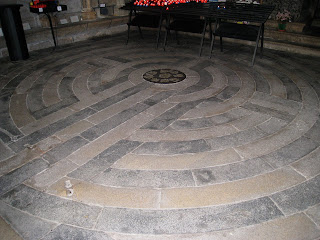New Harmony, Indiana has two labyrinths. The labyrinth symbolized for the Harmonists the difficult path of life to reach true harmony and perfection.
The Cathedral Labyrinth is outdoors and duplicates the original labyrinth at Chartres Cathedral. This labyrinth is constructed of polished granite. The rose in the middle of the labyrinth identifies its Chartres origin. The labyrinth builder and architects traveled to Chartres Cathedral to make an exact copy of the labyrinth.
The park in which the labyrinth is located was made specifically for the labyrinth, imitating the dimensions of the nave of the Chartres Cathedral. It was dedicated in October of 1998, by the then Rector of the Chartres Cathedral, Chanoine Francois Legaux. Janet Lawrence of Historic New Harmony cares for the labyrinth and hosts solstice walks. During the town's popular Heritage week labyrinth walks are held and specifically for children.
There is also a fountain added so that people can wash their feet before or after walking the labyrinth if they choose to walk it barefoot.
The park in which the Cathedral labyrinth is located was made specifically for the labyrinth, imitating the dimensions of the nave of Chartres Cathedral.
The other labyrinth, the Harmonist Labyrinth was originally built around 1815. It was then reconstructed in 1939 with hedges planted in a concentric circular pattern with one path which was established by the Harmony Society.
A small stone building called a grotto is placed at the centre, an authentic restoration of the Harmonist grotto.
























































